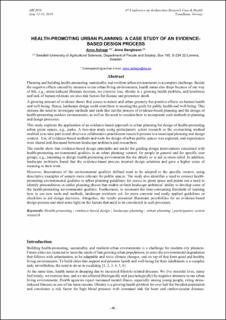| dc.description.abstract | Planning and building health-promoting, sustainable, and resilient urban environments is a complex challenge. Beside the negative effects caused by stressors in our urban living environments, health status also drops because of our way of life, e.g., stress-induced illnesses increase, we exercise less, obesity is a growing health problem, and loneliness and lack of human relations are also risk factors for disease and premature death.
A growing amount of evidence shows that access to nature and urban greenery has positive effects on human health and well-being. Hence, landscape design could contribute to meeting the goals for public health and well-being. Thisstresses the need to investigate methods and tools that aid the process of evidence-based planning and the design of health-promoting outdoor environments, as well as the need to consider how to incorporate such methods in planning and design processes.
This study explores the application of an evidence-based approach in urban planning for design of health-promoting urban green spaces, e.g., parks. A two-step study using participatory action research as the overarching method enabled us to take part in and observe a collaborative practitioner-research process in a municipal planning and design context. Use of evidence-based methods and tools for design of urban public spaces was explored, and experiences were shared and discussed between landscape architects and researchers.
The results show that evidence-based design principles are useful for guiding design interventions concerned with health-promoting environmental qualities in an urban planning context, for people in general and for specific user groups, e.g., intending to design health promoting environments for the elderly or to aid in stress relief. In addition, landscape architects found that the evidence-based process inspired design solutions and gave a higher sense of meaning to their work.
However, descriptions of the environmental qualities defined need to be adapted to the specific context, using descriptive examples of aspects more relevant for public spaces. The study also identifies a need to connect healthpromoting environmental qualities to urban planning guidelines for access to green space and points out a need to identify preconditions in earlier planning phases that enable or limit landscape architects’ ability to develop some of the health-promoting environmental qualities. Furthermore, to surmount the time-consuming threshold of learning how to use new tools and methods, landscape architects ask for more concrete and easily applied guidelines or checklists to aid design decisions. Altogether, the results presented illuminate possibilities for an evidence-based design process and shed some light on the factors that need to be considered in such processes. | en_US |

